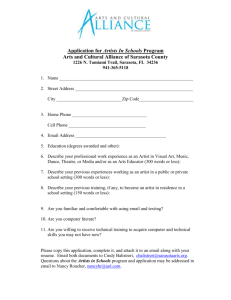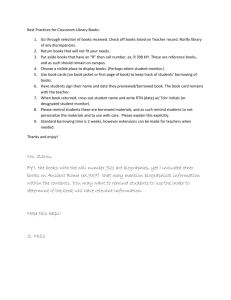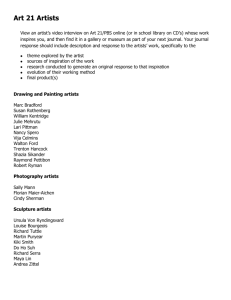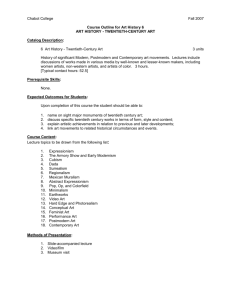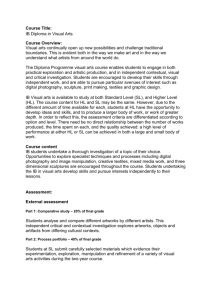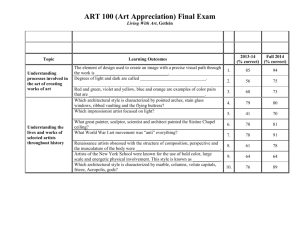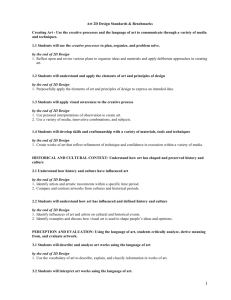Borrowing & Appropriation in Art: History & Contemporary Use
advertisement
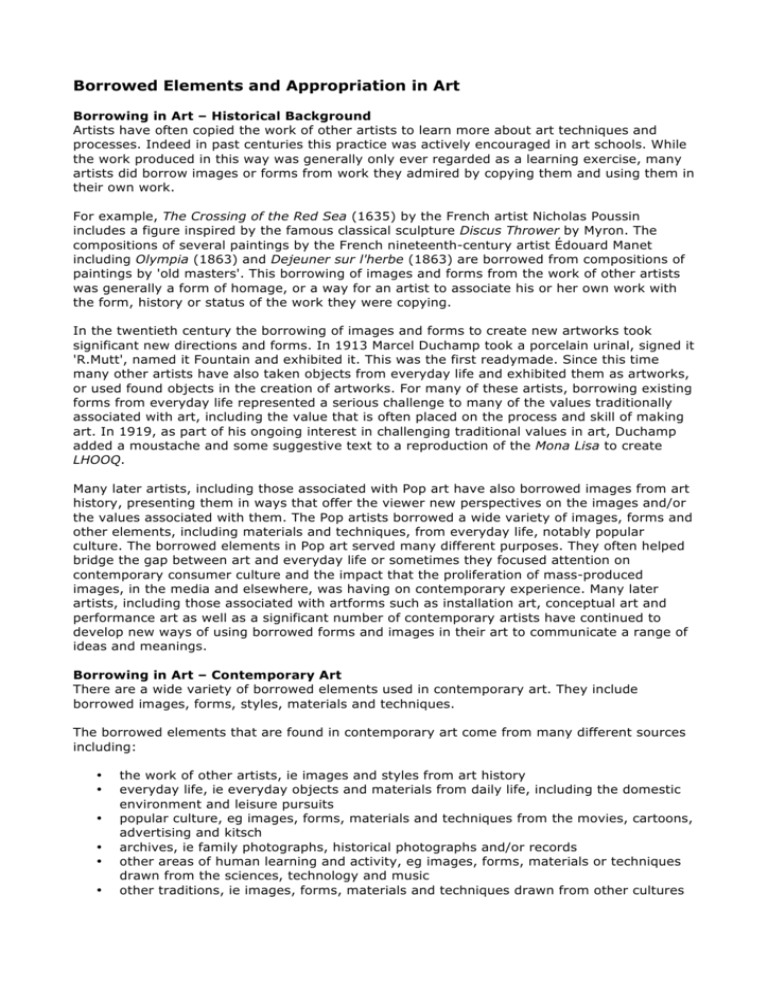
Borrowed Elements and Appropriation in Art Borrowing in Art – Historical Background Artists have often copied the work of other artists to learn more about art techniques and processes. Indeed in past centuries this practice was actively encouraged in art schools. While the work produced in this way was generally only ever regarded as a learning exercise, many artists did borrow images or forms from work they admired by copying them and using them in their own work. For example, The Crossing of the Red Sea (1635) by the French artist Nicholas Poussin includes a figure inspired by the famous classical sculpture Discus Thrower by Myron. The compositions of several paintings by the French nineteenth-century artist Édouard Manet including Olympia (1863) and Dejeuner sur l'herbe (1863) are borrowed from compositions of paintings by 'old masters'. This borrowing of images and forms from the work of other artists was generally a form of homage, or a way for an artist to associate his or her own work with the form, history or status of the work they were copying. In the twentieth century the borrowing of images and forms to create new artworks took significant new directions and forms. In 1913 Marcel Duchamp took a porcelain urinal, signed it 'R.Mutt', named it Fountain and exhibited it. This was the first readymade. Since this time many other artists have also taken objects from everyday life and exhibited them as artworks, or used found objects in the creation of artworks. For many of these artists, borrowing existing forms from everyday life represented a serious challenge to many of the values traditionally associated with art, including the value that is often placed on the process and skill of making art. In 1919, as part of his ongoing interest in challenging traditional values in art, Duchamp added a moustache and some suggestive text to a reproduction of the Mona Lisa to create LHOOQ. Many later artists, including those associated with Pop art have also borrowed images from art history, presenting them in ways that offer the viewer new perspectives on the images and/or the values associated with them. The Pop artists borrowed a wide variety of images, forms and other elements, including materials and techniques, from everyday life, notably popular culture. The borrowed elements in Pop art served many different purposes. They often helped bridge the gap between art and everyday life or sometimes they focused attention on contemporary consumer culture and the impact that the proliferation of mass-produced images, in the media and elsewhere, was having on contemporary experience. Many later artists, including those associated with artforms such as installation art, conceptual art and performance art as well as a significant number of contemporary artists have continued to develop new ways of using borrowed forms and images in their art to communicate a range of ideas and meanings. Borrowing in Art – Contemporary Art There are a wide variety of borrowed elements used in contemporary art. They include borrowed images, forms, styles, materials and techniques. The borrowed elements that are found in contemporary art come from many different sources including: • • • • • • the work of other artists, ie images and styles from art history everyday life, ie everyday objects and materials from daily life, including the domestic environment and leisure pursuits popular culture, eg images, forms, materials and techniques from the movies, cartoons, advertising and kitsch archives, ie family photographs, historical photographs and/or records other areas of human learning and activity, eg images, forms, materials or techniques drawn from the sciences, technology and music other traditions, ie images, forms, materials and techniques drawn from other cultures Borrowed elements can be used alone, or in conjunction with traditional art elements to make artworks. Frequently an artist's use of borrowed elements involves parody, irony, subversion or humour. Materials, Objects, Techniques Some contemporary artists who work with borrowed elements do so by using actual objects, materials and techniques from everyday life and popular culture to create an artwork, or part of an artwork. While everyday objects, materials and techniques are often chosen and used by artists for their appearance, meaning, function or value, they can sometimes take on different appearances or meanings, functions or values when they are used to make an artwork. Examples of this are the hardware bits, including plumbing pipes, featured in Taipan by Ricky Swallow, and the items of clothing in Clothing Exchange by collaborative performance group DAMP. Images, Forms, Styles Some contemporary artists who work with borrowed elements do so by copying existing images, forms or styles from art, everyday life and popular culture to make an artwork or part of an artwork. While some copied images, forms or styles closely resemble the original on which they are based, there are always some differences. These differences can range from the subtle to the dramatic, and can be the result of the artist reproducing or reinterpreting the original using different materials or techniques to reproduce or reinterpret the original image form or style. For example, the use of photography to recreate paintings in selected works by Anne Zahalka. Other examples include the use of plastics and other materials to create simulacra of real objects in selected works by Ricky Swallow; the enlargement of plastic blow up toys in selected works by Christopher Langton; and the reduction of buildings to small scale models in works by Callum Morton. Artists often bring great personal expression and style and new details and ideas to their interpretation of borrowed images, forms or styles. For example, the highly personal interpretation of modernist painting styles in work by Angela Brennan; the deletion and addition of particular details in the reworking of an existing image in selected works by Anne Zahalka; and the application of traditional Chinese porcelain decorating techniques to portrait busts in the China China series by Ah Xian. Borrowing & Appropriation? To appropriate something is to take possession of it. In art commentaries the term appropriation is often used in a general way to refer to the use made of borrowed elements in creation of new work. These might include images, forms or styles from art history or popular culture, or materials and techniques from non-art contexts. However, since the 1980s, the term 'appropriation' has also had a much more specific meaning. Since this time, the term has been closely associated with the process of 'quoting' the work of another artist to create a new work. Contemporary artists have often used this form of appropriation to present viewers with new perspectives on the quoted work. The term 'appropriation art' has been used to describe artworks that involve this form of quotation. Reasons for Borrowing & Appropriating There are many different, but often overlapping, reasons why borrowed elements are used in contemporary art. Often borrowed elements have visual appeal or associations that traditional art materials cannot provide. Sometimes contemporary artists are specifically interested, for example, in the meanings, values and ideas that borrowed elements carry or suggest. Contemporary artists work with borrowed elements in many different ways to variously explore, exploit, expose, expand, celebrate, revise, challenge and critique their visual qualities and/or the meanings, values or ideas associated with them. Blurring Boundaries For example, using borrowed elements can blur the boundaries between art and other areas. Within contemporary art there is great interest in bridging the gap that has traditionally existed in Western art between art and everyday life, popular culture and other areas of human activity such as science, technology, music etc. By incorporating elements borrowed from these other areas into their work, artists extend and expand traditional ideas about art, including what it is made from (three-dimensional works do not have to be carved from marble, or cast or constructed from metal); how it is presented (a painting does not have to be a flat rectangular surface hanging on the wall); and what it is about (artworks do not have to be about beautiful, inspiring or elevating subjects). The presence of familiar elements in an artwork can also play an important role in encouraging viewers to identify with, explore and engage with a work. Consider, for example, the use of images, techniques and conventions borrowed from contemporary film in Noonan's Saturn Return. Consider also the use of styles and forms drawn from popular culture in the animation and interactive work of Martine Corompt. Alternative Meanings, Ideas & Values Artists often present borrowed elements in new contexts or relationships, or in a different form to how they usually appear. This can transform the appearance of the borrowed elements and suggest alternative ways of thinking about the meanings, ideas and values associated with them. Consider, for example, the addition and deletion of certain details in reinterpretations of images from art history in the Bondi, Playground of the Pacific series by Anne Zahalka. These expose the gender and cultural bias in images that have played a critical role in shaping Australian national identity. Louise Weaver's use of cotton thread and crochet to create a skin over various objects gives this material and technique, traditionally associated with functional domestic or personal items, new aesthetic and symbolic value and meaning. The use of traditional porcelain decorating techniques on portrait busts by Ah Xian affirms the relevance of this technique to contemporary culture. Enlarging the form of inflatable toys, and their presentation in multiples, makes children's playthings appear sinister in Souvenir by Christopher Langton, encouraging us to recognise that even innocent objects like toys can convey strong messages and ideas. The presentation of household objects as artefacts raises issues about contemporary consumer culture, history and the museum in works by Callum Morton. The juxtaposition of a rowdy soundtrack with a model of Captain Cook's cottage in Cottage Industry: Bawdy Nights raises issues related to the role of the cottage as a historic/tourist icon. Death of the Original Using borrowed elements challenges the idea that an artwork must be entirely original. Historically there has been great value placed on the idea that an artwork is a unique and original object created by an individual artist. However, this idea has little or no relevance for many contemporary artists. In a world saturated by visual images many artists now believe that it is impossible to create a genuinely original image. They believe the appearance and meaning of any artwork is the product not just of an artist but of many outside influences. Instead of being a creator of original images, the artist is seen as a manipulator of existing images, forms and styles. This belief has led artists to freely borrow and rework images, forms and styles from art and popular culture – often to explore new ways of working with them or to reveal new ways of understanding them. Consider, for example, the highly personal and expressive style used by Angela Brennan to create works that have a loose affinity with hard-edge Modernist styles. These works expand traditional understandings that characterise these hard-edge modernist styles as cool, formal and controlled. The restaging of compositions from art history with different details, and in a different medium, in selected works by Anne Zahalka exposes and critiques the gender and racial stereotypes associated with national identity. Anne Zahalka's appropriation of 'masterpieces' from art history might also raise questions about who decides what a masterpiece is, and why some artworks have been more highly valued than others in art history. A DEFINITION Appropriation To appropriate something is to take possession of it. In the visual arts the term appropriation is often used in a general way to refer to the use made of borrowed elements in the creation of new work. These borrowed elements might include images, forms or styles from art history or popular culture, or materials and techniques from non-art contexts. Since the 1980s, the term 'appropriation' has also had a much more specific meaning. Since this time, the term has been closely associated with the process of 'quoting' the work of another artist to create a new work.

